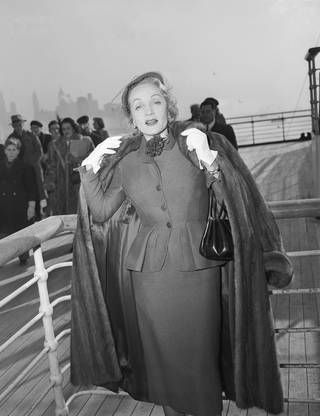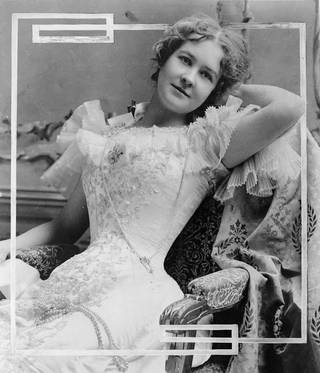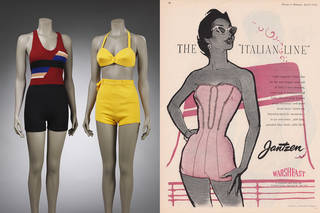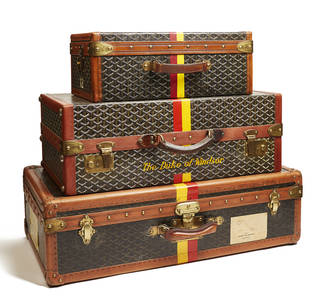Dressing on an ocean liner was more than a case of being practical at sea. To embark on an ocean voyage was to enter a realm of transformative glamour and escapist fantasy. It was an opportunity to see and be seen by the social elite, and fashion became central to the experience.
Travel by land and sea often proves to be the acid test of true chic.
Activities such as deck-tennis, swimming, dining and dancing each required specific attire. But with space at a premium, how did the ocean traveller decide what to pack? From the early 20th century, fashion magazines such as Vogue keenly dispensed sartorial advice to travellers fearful of committing a fashion faux pas. Shipping lines further promoted the association of ocean travel and fashion, often featuring images of slender, elegantly dressed passengers in their advertising brochures.

Embarking and daywear
You will of course, want to do credit to your town and country when you embark, and also when you leave the ship, so put aside your prettiest street costume and most becoming hat for wearing down to the dock.
Boarding and disembarking the ship were crucial moments when passengers were the focus of attention. A smart tailored suit, worn under a warm fur or tweed travel coat, was usually the outfit of choice for a woman embarking on an ocean voyage.
For the woman who goes to Europe, Vogue suggests, first, a suit, of tweed, perhaps, classically and mannishly tailored.
When German-born actress Marlene Dietrich arrived in New York on the Queen Elizabeth in 1950, she was photographed wearing a 'new look' suit by Christian Dior, characterised by its hourglass silhouette and tiny waist. Dietrich was one of the stars of the age who frequently crossed the Atlantic on liners and was often photographed wearing the latest fashions.

Eveningwear – making an entrance
A woman […] swept down the steps of the Ritz [the restaurant on the 'Imperator'] in a draped, white satin gown, her hair swirled high, caught with a diamond comb, and swathed in a long rope of pearls.
As liners became 'floating palaces' modelled on country houses or grand hotels like the Ritz, passengers were advised to dress in suitably elegant attire, and pack their best garments. The 'grande descente' was a spectacular staircase which first-class passengers walked down to enter the dining room in the evening. It was a dramatic backdrop for women wearing the latest fashions – a spectacular stage for social display.
It is a safe rule not to wear on board ship any clothes in which you would be ashamed to be seen where you are best known. First impressions go a long way, and there are so many chances of making pleasant acquaintances on board...
Some dress fabrics, such as chiffon and lace, were considered more practical than others – one writer recommended avoiding ostrich feathers, velvet and tulle and advised: "[s]idestep the metallic evening gown for an ocean trip – it is too dressy and it turns 'green' at sea" (The World is Your Oyster: The Art of Traveling Smartly, Helen Eva Yates, 1939).

In the 1910s and '20s, the American socialite Miss Emilie Grigsby (1876 – 1964) frequently travelled on great ocean liners such as the Olympic, the Aquitania and the Lusitania. She bought garments from the greatest Parisian couturiers of the day, and most likely wore her gowns by Jeanne Lanvin, Madeleine Vionnet and Paul Poiret on board liners.

The V&A acquired much of her wardrobe in the 1960s, including an exquisitely beaded turquoise silk flapper dress designed by Jeanne Lanvin in 1925. Named 'Salambo', the dress evokes the exoticism of Gustave Flaubert's 1862 novel, Salammbô, and reflects the wider trend for oriental themes in the 1920s. The design was exhibited at the Paris 1925 International Exhibition of Modern Decorative and Industrial Arts – a pivotal moment in the global boom of Art Deco style.

Accessories
Though it was advised not to bring valuables onboard, many women travelled with their finest jewels. In May 1915, Lady Marguerite Allan was travelling on the Lusitania accompanied by two of her daughters and two maids, with her fashionable diamond and pearl Cartier tiara in her luggage. When the ship was torpedoed by a German U-boat, she managed to escape with her maids, one of whom was able to save the tiara. Tragically, her daughters were among the 1,198 who died when the Lusitania sank.

Menswear
A 1907 traveller's handbook recommended that men pack sparingly: a black coat for dinner and appropriate shirts were the only luxury items needed, but "fancy shirts are entirely out of place". Such strict fashion conventions were still at play several decades later. When travelling on board Queen Elizabeth 2 in 1969, British businessman Geoffrey Osmint wore a vibrantly zig-zag patterned evening suit for dinner at the Captain's table. The fashionable suit was designed by Tom Gilbey on Savile Row in London, and was made of a striking blue fabric, paired with a floral cravat. Once on board, Osmint realised the dress code was rather more conservative and recalled:
I am afraid we stood out by not being conventional and wearing traditional 'black tie'!

Anthony J. Drexel Biddle Jr, known as 'Tony', was an American diplomat whose style was legendary. During the Second World War (1939 – 45) he was ambassador to governments in exile in London and frequently crossed the Atlantic by ocean liner on his diplomatic missions. Biddle was often listed among America's best-dressed men between the 1930s and 1950s. His day suit features a double-breasted striped wool jacket with wide lapels.

Leisurewear
Little two-piece sports dresses of crêpe de Chine [...] may be worn from the time one comes on deck in the morning sunshine till one disappears to dress for dinner.
With the growth of leisure activities during the 1920s and '30s, decks were transformed into open expanses offering a vast range of activities, from quoits to deck-tennis and clay-pigeon shooting. Sportswear became an essential part of a traveller's wardrobe.

Fashionable swimwear was de rigueur on board with Vogue recommending packing swimming costumes along with day and evening dresses. By the 1930s, fashion sketches and photographs frequently featured models posing next to swimming pools wearing the latest swimsuits. In the 1950s American swimwear company Janzten advertised a new 'Italian Line' of swimsuits for fashion-conscious passengers. Through the shirring and ruching of fabric and some 'magic Jantzen shapemakery', the swimsuits created the coveted hourglass silhouette.

Luggage
Chic and practical luggage by Louis Vuitton or Maison Goyard was indispensable to wealthy travellers. Well-seasoned travellers owned a set of luggage, including several trunks ingeniously designed to pack everything from hats to shoes. So that a traveller's trunks could be recognised easily, each piece was numbered and marked with a coloured stripe and the owner's initials.

The Duke and Duchess of Windsor (the former King Edward VIII and his wife, American divorcee Wallis Simpson), each owned a set of personalised luggage from the exclusive Maison Goyard, founded in Paris in 1853. The elegant couple frequently travelled between France and the USA with astonishing quantities of luggage, once boarding the SS United States with 100 pieces.
The association between fashion and ocean travel was cemented in the 20th-century, as fashion shoots and catwalk shows were frequently organised on deck, against a backdrop of spectacular liner architecture. Today the nautical style remains synonymous with chic elegance, from haute-couture to high-street fashion.

Main image © French Lines Collection, Le Havre, France.


